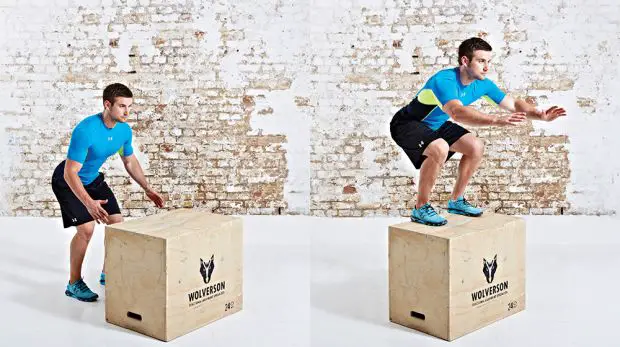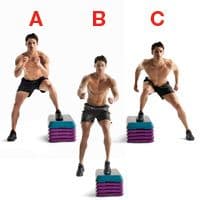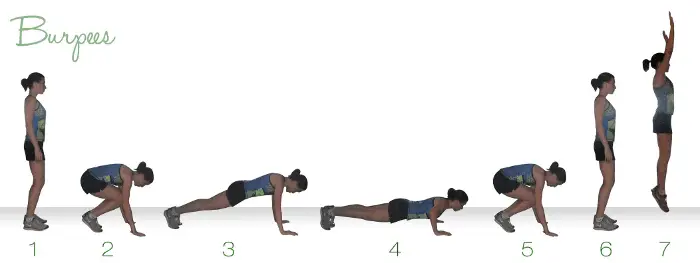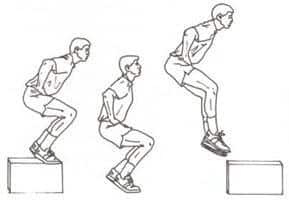I think it goes without saying that in order to be a high flyer, unless gifted with some pretty unique and fantastic genes. You will need to spend some time performing exercises or putting time into the gym.
But I get it, it’s not always possible to get to the gym and do a full workout.
Just because you can’t get to the gym doesn’t mean you should miss out on the gains from your workouts.
In this article I am going to go over some of the best plyometric exercises for Volleyball that will turn you into a jumping machine.
Some of these exercises will require equipment but get creative. Anything that offers resistance is perfectly fine, this can be anything from dumbbells to bags of sugar.
Where a platform is required you can make use of benches or chairs etc..
Table of Contents
Warning
Now before I get into the exercises I want to stress how important it is that a full body warm up is carried out before performing any of the activities.
A warm up is equally as important if not more important to ensure you reduce the risk of injuries that might put you out of action.
Following on from that I would suggest that you do not perform these activities if you have a long term injury or are recovering from a recent injury that made be affected by these exercises.
The last point I want to make very clear is to ensure each exercise is done using the correct technique.
If any of these exercises are performed using the wrong technique it may actually cause more harm than good.
If you have any doubts about technique it may be a good idea to ask a coach or professional to spot you.
Squats
What does it work?
Squats are a strength exercise which focus on your hamstrings, glutes and quadriceps.
Although these are the main muscles worked you also work your calves, hip abductors and core.

What Does it Improve?
The muscles mentioned above play a big part in how high you can jump, by increasing the strength of the muscles this in turn can translate into the potential power you can produce when performing the jumping exercise.
Obviously the more power you have available to perform the jump, the more explosive you can be.
How to Perform a squat?
So now you know the benefits of the squat let’s get into how to perform the squat.
A squat can be performed with or without weights. Obviously if you are a beginner to this exercise or a beginner to leg training in general I would suggest you do this exercise without weights to understand and perfect the technique.
If you are using a bar and weights you want to rest the bar along the top of your shoulders.
Tilt your head forward slightly and raise your shoulders slightly to ensure the bar sits comfortably.
If you are not using a bar I would suggest you either raise your arms up to the side as if you were carrying a bar so that it doesn’t feel alien when you work up to weights.
Alternatively you can place your arms against your side and then cross them on your chest to keep them out of the way.
Ensure your feet are approximately shoulder width apart and begin your squat by sitting back into your ankles.
To perform this you want to start by pushing your hips backwards whilst slowly bending your knees. It is important to keep your core tight and back straight at all times throughout the movement.
Another important thing to note is that when you are squatting you want to bend your knees and not let them flare outwards as this will put unnecessary stress on your knee joint and ligaments.
Continue this movement until you are in fully squatted position.
You will know you have reached the limit of your flexibility as you will feel your back push out into a slouched position of your heels will want to leave the ground. If either of these things occur you are squatting too deep and should only squat within your means.
You will see lots of teachings explaining the ‘correct depth’ however it is far more important to perform these exercises within your range than risk injury.

Squat Jump
What does it work?
Rather Unsurprisingly this squat jump works the same muscles as the original squat however by adding a jumping and landing element the calves play a larger part in this exercise
What Does it Improve?
Squat jumps a fantastic variation to the standard squat with the main emphasis being on really improving the explosive power you are able to generate when performing these exercises.
By performing this exercise you will not only train the muscle memory of explosive jumping but will also improve your explosive power to allow you to jump higher than ever.
How to Perform a jump squat?
The premise of the jump squat is very similar to the traditional squat, however, with this exercise you once you reach a near 90 degree angle you want to explode upwards of the balls of your feet with as much power as possible.
You may also want to use your arms for added momentum.
When coming into land you want to ensure you land correctly on the balls of your feet with your knees slightly bent.
Once you contact the floor you want to carefully descend back into the squat position before repeating the movement.

Box Jump
What does it work?
There will be a bit of a recurring theme here yet again this exercises works the main lower muscles, these include: Hamstrings, Glutes, Quads and Calves
What Does it Improve?
Box Jumps will drastically improve you explosive power making you faster when moving and leaving the ground.
The beautiful thing about this exercise is that you can adapt it to suit your goals. As we are looking at improving vertical jump it would be best to perform higher box jumps at low reps.
How to Perform a Box Jump?
To perform a box jump you first want to find a box or platform that you can jump onto.
It would be wise to start with a height not exceeding 50cm as this will allow you to understand and perfect the correct form, as opposed to aiming to high and smashing your shins into the box.
Once you have found your box or platform, you want to stand in front of the box with your feet shoulder width apart.
Bend into a quarter squat position and whilst doing so swing your arms behind you.
When you begin to swing your arms forward once they pass your body line you should explode upwards and forwards slightly to ensure you land on the box.
When jumping you want to lift your knees towards your chest and land softly in deep squat position.
Step back down from the box and repeat the process until all your reps are completed.
Once you have mastered the technique you begin to increase the height and in turn increase your vertical leap.

Lateral Box Push-offs
What does it work?
Hopefully your legs aren’t too sore yet as yep you guessed it.
This exercise works your Quads, hamstrings, Calves and Glutes
What Does it Improve?
This exercise is more geared to the one foot jumpers amongst us however we have all been in situations in which we need to jump off one foot when playing volleyball.
This exercise also increases explosive power and anaerobic thresholds.
How to Perform a Lateral Box Push-off?
To perform a Lateral box push-off you want to start with one leg on the ground and one foot of a raised surface such as a box.
To perform the Lateral box push-off you want to jump off your leg that is already on the box and use your arms to propel yourself upwards and sideways in a lateral movement.
Once you have jumped you want to land on the other side of the box with your leg that originally on the box on the floor and the leg that was originally on the floor now on the box.
This process is repeated until the desired reps are achieved.

Burpees
What does it work?
This exercise is fantastic in general as it is a full body exercise and is specifically good for explosive movements.
Burpees are effectively a full body workout and with each rep you will work the following areas: arms, chest, quads, glutes, hamstrings, and abs.
What Does it Improve?
As mentioned above Burpees are a fantastic exercise to improve your explosive power and allow you to get into position and off the ground with great speed.
It also helps build upper body strength as well as stamina both aerobically and anaerobically.
How to Perform a Burpee?
To perform a Burpee you want to start in an upright standing position. The first step is to go into a deep squat position before kicking your hips and legs backwards to land in the top of the press up position.
Next you want to perform a press up before pushing yourself upwards and getting your legs back underneath you in a squatted position.
From here you want to explode upwards in a jumping action and stretch your arms high above your head.
Land carefully and repeat the process as quickly and safely as possible until you rep requirement is reached, for more of a stamina builder you can do this for a time period instead of number of repetitions.

Box-Depth Jump
What does it work?
We have gone to one of my all time favourite plyometric exercises.
The Box-Depth Jump.
This is a plyometric exercise that always offer fantastic results.
The Box-Depth jump works the following muscles: Quads, Hamstrings, Glutes and Calves.
What Does it Improve?
This plyometric exercise will you become a more explosive.
It trains the muscles to store elastic energy and convert it into explosive movements.
Much like when you stretch out an elastic band and let go of one end.
The less time you spend on the ground when performing this exercise the quicker you will be able to move and the higher you will fly.
How to Perform a Box-Depth Jump?
To perform a box-depth jump you first want to start by standing on a raised ledge or box with your toes just hanging over the edge.
You want to step ‘not jump’ off the side of the box or ledge. This should be a controlled fall not a leap.
Once you are off the box you want to land carefully on the balls of your feet.
The second you make contact with the floor you want to explode upwards in a jumping action.
This can be done a few different ways. If you have another box I like to step off one box and immediately jump onto the next, this way you can raise the height of the box to challenge yourself more and ensure all of your reps are completed to your full potential.
Much like all these exercises don’t start too high, it is important to get the technique right before worrying about how high you can jump.

Recommended Repetitions depending on fitness levels and experience.
Now I think it goes without saying that you can do these exercises until you’re blue in the face but if you get injured by overdoing it, chances are you won’t see any improvements.
Below is my recommendation repetitions depending on your experience with leg workouts and fitness levels overall.
| Level | Repetitions | Sets |
| New to Leg workouts
Low Fitness Levels Injury Rehab |
5-7 | 3 |
| Some Experience with Leg workouts
Average fitness levels Strength building post injury |
8-10 | 3 |
| Experienced
Good fitness levels No injuries or weaknesses |
5-10 – Add Weight to exercises | 3 |
Now it may be surprising to you that for the experienced section I give such free reign.
Well that is because not only are they experienced enough to determine the correct amount of repetitions for themselves but things such as goals and objectives will come into play.
When doing plyometric exercises specifically to improve vertical jump we are trying to improve explosive power and strength.
This means we want to do low reps with maximum effort and resistance.
By doing low repetitions at maximum effort we train our fast twitch muscle fibres to activate.
If we do lots of repetitions we actually begin to train both fast and slow muscle fibres however lots of reps is generally geared towards slow twitch muscle fibres.
This means we can not be as explosive in our movements and instead will be improving how long we can perform certain movements or activities before muscle fatigue begins to take effect.
So there you have 6 of my favourite exercises that you can do with very little equipment that are sure to see you jumping out the gym in no time.
